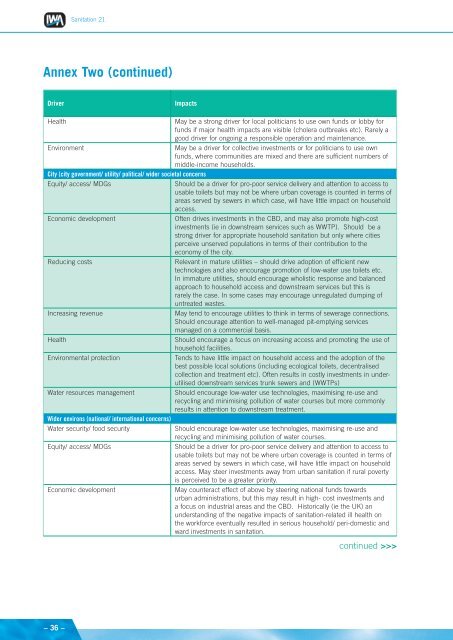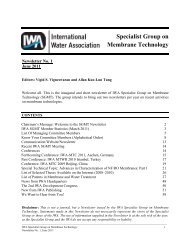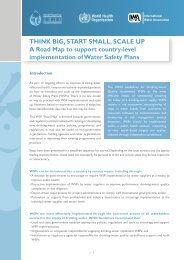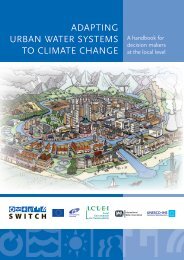Sanitation 21 planning framework - IWA
Sanitation 21 planning framework - IWA
Sanitation 21 planning framework - IWA
- No tags were found...
You also want an ePaper? Increase the reach of your titles
YUMPU automatically turns print PDFs into web optimized ePapers that Google loves.
<strong>Sanitation</strong> <strong>21</strong>Annex Two (continued)DriverImpactsHealthMay be a strong driver for local politicians to use own funds or lobby forfunds if major health impacts are visible (cholera outbreaks etc). Rarely agood driver for ongoing a responsible operation and maintenance.EnvironmentMay be a driver for collective investments or for politicians to use ownfunds, where communities are mixed and there are sufficient numbers ofmiddle-income households.City (city government/ utility/ political/ wider societal concernsEquity/ access/ MDGsShould be a driver for pro-poor service delivery and attention to access tousable toilets but may not be where urban coverage is counted in terms ofareas served by sewers in which case, will have little impact on householdaccess.Economic developmentOften drives investments in the CBD, and may also promote high-costinvestments (ie in downstream services such as WWTP). Should be astrong driver for appropriate household sanitation but only where citiesperceive unserved populations in terms of their contribution to theeconomy of the city.Reducing costsRelevant in mature utilities – should drive adoption of efficient newtechnologies and also encourage promotion of low-water use toilets etc.In immature utilities, should encourage wholistic response and balancedapproach to household access and downstream services but this israrely the case. In some cases may encourage unregulated dumping ofuntreated wastes.Increasing revenueMay tend to encourage utilities to think in terms of sewerage connections.Should encourage attention to well-managed pit-emptying servicesmanaged on a commercial basis.HealthShould encourage a focus on increasing access and promoting the use ofhousehold facilities.Environmental protectionTends to have little impact on household access and the adoption of thebest possible local solutions (including ecological toilets, decentralisedcollection and treatment etc). Often results in costly investments in underutiliseddownstream services trunk sewers and (WWTPs)Water resources managementShould encourage low-water use technologies, maximising re-use andrecycling and minimising pollution of water courses but more commonlyresults in attention to downstream treatment.Wider environs (national/ international concerns)Water security/ food securityEquity/ access/ MDGsEconomic developmentShould encourage low-water use technologies, maximising re-use andrecycling and minimising pollution of water courses.Should be a driver for pro-poor service delivery and attention to access tousable toilets but may not be where urban coverage is counted in terms ofareas served by sewers in which case, will have little impact on householdaccess. May steer investments away from urban sanitation if rural povertyis perceived to be a greater priority.May counteract effect of above by steering national funds towardsurban administrations, but this may result in high- cost investments anda focus on industrial areas and the CBD. Historically (ie the UK) anunderstanding of the negative impacts of sanitation-related ill health onthe workforce eventually resulted in serious household/ peri-domestic andward investments in sanitation.continued >>>– 36 –
















